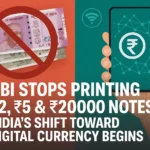The Reserve Bank of India (RBI) has made a historic announcement — ₹2, ₹5, and ₹2000 notes will no longer be printed. This signals a major shift in India’s financial ecosystem. With the rise of UPI and the launch of the Digital Rupee (e₹), cash seems to be losing its charm in India’s digital journey.
But why has the RBI taken this decision? And what does it mean for common people and businesses?
Let’s break it down.
What Did RBI Announce?
According to the RBI’s Annual Report 2024–25, the central bank has:
- Completely stopped printing ₹2, ₹5, and ₹2000 notes
- Shifted focus toward smaller denominations (₹10, ₹20, ₹50, ₹100)
- Increased adoption and testing of digital rupee (e₹)
This is not a demonetization move — all existing notes will remain legal tender, but new ones will not be printed.
Why Did RBI Stop Printing These Notes?
1. Low Usage & Demand
₹2 and ₹5 coins have largely replaced the notes. Even ₹2000 notes are rarely seen in daily use or ATMs.
2. Combatting Hoarding and Black Money
₹2000 note was introduced in 2016 as a temporary high-value currency post-demonetization. Since then, it’s been used more for hoarding and black money transactions than regular use.
3. Boost to Digital Economy
This move aligns with India’s vision of Digital India — where UPI, digital wallets, and now e₹ (digital rupee) dominate everyday transactions.
What is Digital Rupee (e₹)?
The Digital Rupee (e₹) is India’s official central bank digital currency (CBDC) — launched by RBI.
- Works like physical cash but in digital format
- Can be stored in e-wallets issued by banks
- Works offline and online
- Backed by RBI = safe, stable, and regulated
What Happens to Existing Notes?
- ₹2, ₹5, ₹2000 notes are still legal — they will not be banned
- But over time, they will vanish from circulation
- RBI is slowly withdrawing them from banks and public use
You don’t need to rush to the bank to exchange them — just use them as usual.
What Does This Mean for You?
For Common People:
- You’ll see less cash, more QR codes
- e₹ will become an everyday option — especially in govt. subsidies and rural payments
- Less chance of fake notes
For Businesses:
- More digital compliance, less cash dealing
- Higher UPI & e₹ integration
- Easy accounting and lower risk of cash theft
How Digital India is Evolving
India’s digital payments ecosystem is already one of the best in the world:
- UPI crossed 12 billion transactions in a month
- RuPay, Aadhaar Pay, DigiLocker, and now e₹ are redefining financial access
- Even small vendors now accept digital payments — chaiwala se leke kirana tak!
The Future: Will India Go 100% Cashless?
Not immediately — rural India still depends on cash. But step by step:
- Government subsidies may go via e₹
- Tax compliance will become easier
- Counterfeit money and black economy will reduce
- RBI aims to make India a “Less Cash Society”, not cashless… yet
Criticism & Concerns
Some critics argue that:
- Rural areas need better infrastructure first
- Digital literacy is still low in many regions
- Cybersecurity of e₹ systems must be foolproof
These are valid concerns, and RBI must address them as adoption rises.
Final Thoughts
This is not just about stopping currency printing — it’s a step toward reshaping how India spends, saves, and grows. As RBI pivots to a more transparent, efficient, and cashless economy, we as citizens must adapt and learn.






